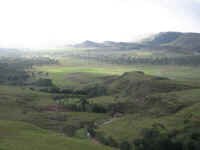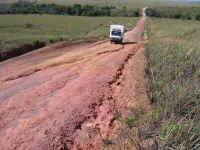July 30, 2005
We left the Fuso at the camp today and caught a ride into Ciudad Bolivar so that we could explore the old colonial heart of the city. The old part of town is not very large when compared to the size of the entire city, it covers an area of maybe a dozen blocks. It is located on a hill overlooking the Orinoco River so we had to start with a climb up to the top where the cathedral is located along with yet another park dedicated to Simon Bolivar. However this park has an interesting twist. It was in this park, against the wall of the church that the liberator of the city, General Manuel Piar was executed on the order of Simon Bolivar after he refused to submit to rule by Bolivar. Very ironic.
The city itself is not very impressive. In the old town, the building facades have been painted in bright colors, the streets are of cobblestones and the area is very clean. We were just surprised to find the area strangely empty of people, not withstanding the fact that it was Sunday.
Leaving the old town and heading to the river we found the people of the city. We expected to find people out for a stroll with their families, but we found the streets filled with clothes stalls and shoppers. Unfortunately, along the waterfront we found many people, apparently homeless and drinking, making for an uncomfortable feeling for walking the area.
July 31
We are on our way to the Gran Sabana, an area full of natural features, waterfalls and tepuis, and the main route south through Venezuela and into Brazil. Brazil requires a visa, and since we were unable to obtain them in Caracas we are planning to arrive at the consulate in Ciudad Guyana when they open tomorrow to try and get the visas.
It took us less than two hours of driving to arrive in the city, so we ran some errands and did some shopping. We were also scouting around for an area to camp for the night. We found a hotel and a police station but in the end we decided to park in the lot at the airport. Yes it sounds strange, but there aren't many camping areas so we often end up in a parking lot that has a security guard - and we felt that the airport lot would be very secure. Once the planes stopped taking off about 10pm it was actually very quiet, even though we were awakened once by a couple of taxi drivers wandering around the Fuso just checking it out. They probably didn't realize that we were asleep inside.
August 1
We arrived bright and early at the Brazilian Consulate, only to find that we were too early, come back in an hour we were told. So we came back and then were told that the visa person wasn't in yet. When would they arrive we asked, soon, was the reply. Another hour and we were told the same thing. Well, we're not even sure that we can get our visa in one day here so how much time do we want to spend waiting. This is an issue in developing countries among workers, especially in government or bureaucratic positions. Some workers don't care about doing their jobs efficiently so their laziness has a ripple effect into the overall economy. People have to take time off from their work to attend to bureaucratic requirements, and the longer they have to wait, the longer they cannot work, they lose income and their absence causes other people to have to wait and/or lose income as well.
We asked what the chances were of getting our visa at the border and were told, oh it is very easy. OK, now this is a chancy thing to try. The border is a two day drive from here in the best circumstances, and if they won't give us visas to enter Brazil what will we do? Kim and I discuss it and decide to take the chance anyway. Maybe we can go to the consulate at the border directly, so if it takes a few days to process our applications we can still go exploring the tepuis in the countryside.
Our destination tonight will now be the gold mining town of El Dorado, right at the edge of the Gran Sabana. The Spanish conquistadors looked for years for the mythical city of El Dorado with its streets of gold thinking that it was somewhere in South America, most likely in Venezuela. Well, the city was never found as it was just a myth, however, in the 19th century gold was found and the miners named their find after the mythical city.
At lunch time we decided to stop at a roadside restaurant to see if they were selling any regional specialty dishes. We made a lucky choice and yes, we were treated to a magnificent meal of roasted pork chops on a fried, sweet, corn bread patty served together with a great big slice of locally made cheese. Oh boy was it good. We later looked it up in our guidebook to find the name. "Cachapa" is what it is called and we will look for it again!
When we finally arrived in El Dorado, we were stunned. The town had a "wild west" feel, it was really filthy, and gave us an uncomfortable feeling. This was made even worse by the fact that this was the first town to have soldiers standing around in the street and at both ends of the gas station with their machine guns. It made us wonder if there was something else going on, but we didn't hear of anything. It is just that this town must not be very safe. So we turned around and decided to find someplace else to set up camp. Just a few miles down the road we found a nice small park that was set up with a small stage and covered picnic areas for families, probably for use on the weekends. We asked the fellow who was tending a garden there if we could spend the night and he said yes, no problem. And to settle our nerves, he indicated that the park was very tranquil and safe.
After setting up camp, we spotted three toucans in a nearby tree and were able to identify them as new birds for us, they were red billed toucans.
August 2
In the morning, we saw several more birds, including two hawks and some blue-headed parrots.
Heading off toward the Gran Sabana, we passed through a couple more mining towns with the same feeling as El Dorado. We stopped at a town called "Kilometer 88" and filled up with gas. Once again, there were soldiers guarding the gas station and we were able to ask the attendant what was up. He replied that it was the president's idea. We took that to mean that the soldiers needed something to do, so the president has them guarding gas stations. What's to guard when the price of gas is one of the lowest in the world? At this gas stop we topped off our tank and filled our three 5-gallon fuel containers and it cost us about $2.00 US.
Driving up the "Escalara" (staircase), we climbed onto the plateau where the Gran Sabana is located. We came up out of the hot and humid jungle to an elevation of 800m (2,640ft). Not terribly high, but every little bit helps. With a little breeze and the cloud cover since its rainy season, the temperature is a lot more pleasant.
| Our Lonely Planet guidebook describes the Gran Sabana as "Vast, wild, beautiful, empty and silent. One of the country's most enchanting and unusual regions." And it is. This rolling grassland is filled with Venezuela's most striking feature, the tepuis, and when it is clear, the views are endless. It is also filled with tons of waterfalls. One around every turn it seems. |
|
Our destination for today was the Pembóm village of Iberibo, where we could catch a boat to the waterfall Salto Aponguao. We made the turnoff for the village at about 1:30. It was then 43km (27mi) to the village on a dirt road. The road wasn't in terrible shape, but there were some stretches that were really potholed and rough. Add to that the mud patches that we had to avoid and the going was pretty slow. As we turned off for the final six miles, we noticed that clouds were building on the horizon. Hmmm. We continued our steady pace and made our way toward the village, but the condition of the road deteriorated and many side roads split off from it, making it difficult to tell which direction to take. It seems that when it rains, the road gets really muddy so drivers go all over trying not to get stuck. We tried to find the best path but still had to drive through some nasty mud bogs. To make matters worse, the last two miles were driven in the pouring rain. The road deteriorated further and actually became a running stream, obliterating the tracks that we were using to find the right trail to the village. Using our best judgment and 4 wheel driving skills, we drove over rocks, across streams and through lots of wet sand to finally reach the village, three hours after we turned off the highway.
|
|
This was our first real off-roading test for the Fuso and we were really pleased with its performance. During the last 6 miles we had the vehicle in four-wheel drive and never felt that it hesitated or slipped. It did everything we asked of it and it arrived at the village to sit proudly next to all the Land Rovers, Land Cruisers and Troopers already assembled there. |
August 3
Today we took a boat down the Rio Aponguao to visit the waterfall. The falls are 105m (347ft) high and in the rainy season can be as wide as 80m (264ft). We landed at the top of the falls and were able to hike down to the bottom. At the bottom we were hit with the full force of the wind and spray that the waterfall generates. It was pretty impressive.
After lunch, we decided to drive only part way back to the main road and find a place to camp out in the outback. About halfway back to the highway, we turned off on one of the few side roads and discovered a small lake. We were out of sight of the road and on a nice level pad where we could explore the area. It turned out to be a wonderfully quiet and beautiful spot.
August 4
Heading out to the main highway, we got to slowly retrace our steps out the rutted road while other four wheel vehicles sped by hitting all the potholes. Just before we made it back to pavement, we saw a track that lead off to an airstrip we had noticed on the way in two days ago. Thinking "Why not?", we drove the final mile down a nice smooth, paved airstrip. This was definitely a first for us, we had never driven on a runway before!
Back on the main road towards Santa Elena and the Brazil border, we seemed to stop every few miles to view or hike to a waterfall. The Gran Sabana has so many waterfalls that our guide book refers to the number as embarrassing. Just outside of town, we found a nice quiet area away from the road where we set up camp for anther night. Tomorrow is a work day, getting fuel, getting our Brazil visas and doing anything else that is necessary before heading into Brazil and down to the Amazon.

